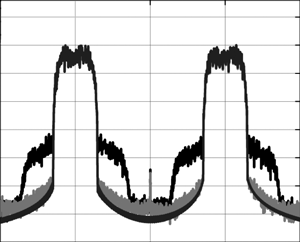Adaptive digital corrector for dual-band data transmission system under quadrature distortions
DOI:
https://doi.org/10.3103/S0735272720030024Keywords:
power amplifier, concurrent dual-band data transmission, digital predistortion method, quadrature unbalance, neural networkAbstract
The digital compensation process for nonlinearly inertial characteristic of the transmit path of dual-band communication system with concurrent data transmission in the presence of unbalance of modulator quadratures has been considered. Analytical relationships enabling us to identify adaptively or change the parameters of dual-band polynomial model of corrector with due regard for the modulator quadrature distortions caused by the LMS, RLS and conjugate gradient algorithms are derived. A model of corrector based on the neural network representing a multilayer perceptron was built for the system. Experimental comparative analysis of the linearization efficiency of link with 25 W power amplifier using correctors with polynomial and neural network architecture is carried out. A comparative analysis of convergence speed, computational complexity and the linearization efficiency of adaptive algorithms (LMS, RLS and conjugate gradient algorithm) based on the polynomial architecture has been performed. The signals using 16QAM modulation with bandwidth of 4 MHz and frequency tune-out of 16 MHz are used as test signals. The results of experimental analysis show the highest computational efficiency without any loss of linearization quality of polynomial compensator that is identified by the conjugate gradient algorithm.References
- Q. Lu and C. Yu, “In-Band Digital Predistortion for Concurrent Dual-Broadband Phased Array Transmitters,” IEEE Microw. Wirel. Components Lett., vol. 29, no. 4, pp. 294–296, 2019, doi: https://doi.org/10.1109/LMWC.2019.2902725.
- L. I. Averina, V. D. Shutov, R. A. Rybalkin, “Structureless modeling of power amplifiers accounting for inertial properties,” Radioelectron. Commun. Syst., v.56, n.1, p.42, 2013. DOI: https://doi.org/10.3103/S0735272713010056.
- L. I. Averina and S. S. Lavlinskii, “Two-block model of a digital corrector for linearization of an analog radio channel,” J. Commun. Technol. Electron., vol. 62, no. 7, pp. 794–799, 2017, doi: https://doi.org/10.1134/S1064226917070014.
- C. Yu et al., “A square-root-based memory polynomial model for concurrent dual-band digital predistortion,” IEEE Microw. Wirel. Components Lett., vol. 29, no. 2, pp. 152–154, 2019, doi: https://doi.org/10.1109/LMWC.2018.2886634.
- S. A. Bassam, M. H. Helaoui, and F. M. Ghannouchi, “2-D digital predistortion (2-D-DPD) architecture for concurrent dual-band transmitters,” IEEE Trans. Microw. Theory Tech., vol. 59, no. 10 PART 1, pp. 2547–2553, 2011, doi: https://doi.org/10.1109/TMTT.2011.2163802.
- S. Lajnef, N. Boulejfen, A. Abdelhafiz, and F. M. Ghannouchi, “Two-dimensional cartesian memory polynomial model for nonlinearity and I/Q imperfection compensation in concurrent dual-band transmitters,” IEEE Trans. Circuits Syst. II Express Briefs, vol. 63, no. 1, pp. 14–18, 2016, doi: https://doi.org/10.1109/TCSII.2015.2482678.
- L. Li, F. Liu, G. Yang, and H. Wang, “A pruning method of joint 2D digital predistortion model for nonlinearity and I/Q imperfections in concurrent dual-band transmitters,” in 2014 IEEE/ACIS 13th International Conference on Computer and Information Science, ICIS 2014 - Proceedings, 2014, pp. 71–74, doi: https://doi.org/10.1109/ICIS.2014.6912110.
- V. I. Djigan, Adaptive Filtering of Signals: Theory and Algorithms [in Russian] (Tekhnosfera,Moscow, 2013).
- D. G. Luenberger, Linear and Nonlinear Programming. Springer, 2008.
- L. I. Averina and O. V. Bugrov, “Digital predistorters based on neural networks for linearization of power amplifiers,” Vestnik VGU. Ser. Fizika, Matematika, n.1, p.5, 2017. URI: https://elibrary.ru/item.asp?id=28989670.

Downloads
Published
2020-03-22
Issue
Section
Research Articles

